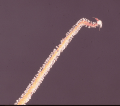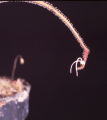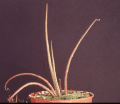 side view of plant with developing tip sprout
side view of plant with developing tip sprout
 closeup of dewey glands and developing tip sprout
closeup of dewey glands and developing tip sprout
 closeup of dewey glands and developing tip sprout
closeup of dewey glands and developing tip sprout
 closeup of developing tip sprout
closeup of developing tip sprout
 closeup of developing tip sprout with root hairs
closeup of developing tip sprout with root hairs
 closeup of developing tip sprout rooting into soil
closeup of developing tip sprout rooting into soil
 several pots of plants in cultivation
several pots of plants in cultivation
 sideview of plants
sideview of plants
 side view of plant with long leaves
side view of plant with long leaves
Pinguicula heterophylla is a most unusual Mexican Pinguicula, the long thread like leaves give the plant a spidery appearance quite different from the foliage of more familiar species in cultivation such as P.moranensis. In winter the plant retreats to an underground 'winter rosette' which is more like a bulb or tuber being whitish in colour and covered with a black papery sheath. This 'bulb' is liable to rot if the plant is kept damp and thus this is another Mexican species which should be subjected to dry conditions over the winter. A balance however has to be struck as if kept too dry for too long there is the risk of desiccation and the loss of the plant. Images 1 and 2 demonstrate the spidery appearance of this species.
The observant will notice the presence of small plantlets on the tips of some of the leaves and in horticultural circles these (plantlet forming) plants are often referred to as the 'alfredae' form. The ability to form plantlets appears to be comparatively unusual with few plants in habitat showing this ability. Herbarium material including the photographs in Jost Caspers 1966 Monographie Der Gattung Pinguicula do not show plantlets on the tips of the leaves, so perhaps the occurrence of this behaviour in habitat would make an interesting study. The 'alfredae' plants have been in cultivation since the 1980's and yet have remained uncommon in collections despite the formation of these plantlets. Other examples of P.heterophylla have entered cultivation after seed was collected in Mexico from Conception Papalo in the mid '90's, I believe these plants are now more widely cultivated (in Europe) compared to the 'alfredea' form.
Plantlet formation is first noticed as the presence of a small white knob of tissue on the ends of some leaves. A red dot appears from which a shoot and then leaves develop, Images 3 and 4 illustrate this. As the shoot develops, dropper roots also form from the tissue and the element starts to look like a miniature plant. This is displayed in images 5 and 6.
As the leaf ages, and under the weight of the developing plantlet the leaves start to arch over. If the plantlet manages to make contact with a suitable substrate, it may take root and form an independent plant once the parent leaf has senesced. Image 7 shows a plantlet taking root in a pot containing other juvenile P.heterophylla plants.
With in a short period of time this small plant will also be forming plantlets of its own.
Finally images 8 and 9 show a number of pots of this species bunched up together to allow the plantlets to root in adjacent pots. (There are over 50 plants of various sizes and stages of development in the images). The potting media I use contains a proportion of either crushed chalk or tufa rock as well as more familiar perlite, vermiculite, sand and some moss peat. P.heterophylla is yet another Pinguicula species which prefers a more basic compost, after all these are not typical bogland CPs. Other materials such as crushed limestone or dolomite lime should be equally suitable.